Analyzing Continuous Improvement at Coca-Cola Company
VerifiedAdded on 2023/06/13
|13
|3187
|388
Case Study
AI Summary
This case study examines The Coca-Cola Company's approach to continuous improvement, focusing on sustainability, mentoring programs, and skill-building initiatives. The company emphasizes optimum resource utilization, recycling programs, and employee development through mentoring and training workshops. The continuous improvement plan involves planning, implementation, checking outcomes, and acting on successful strategies. Key aspects of continuous improvement, such as communication, sustainability, coaching, mentoring, and knowledge management, are discussed. The study also outlines the four key steps for monitoring operational progress and the factors influencing communication methods. This analysis highlights Coca-Cola's commitment to enhancing productivity, employee engagement, and adapting to the dynamic business environment.
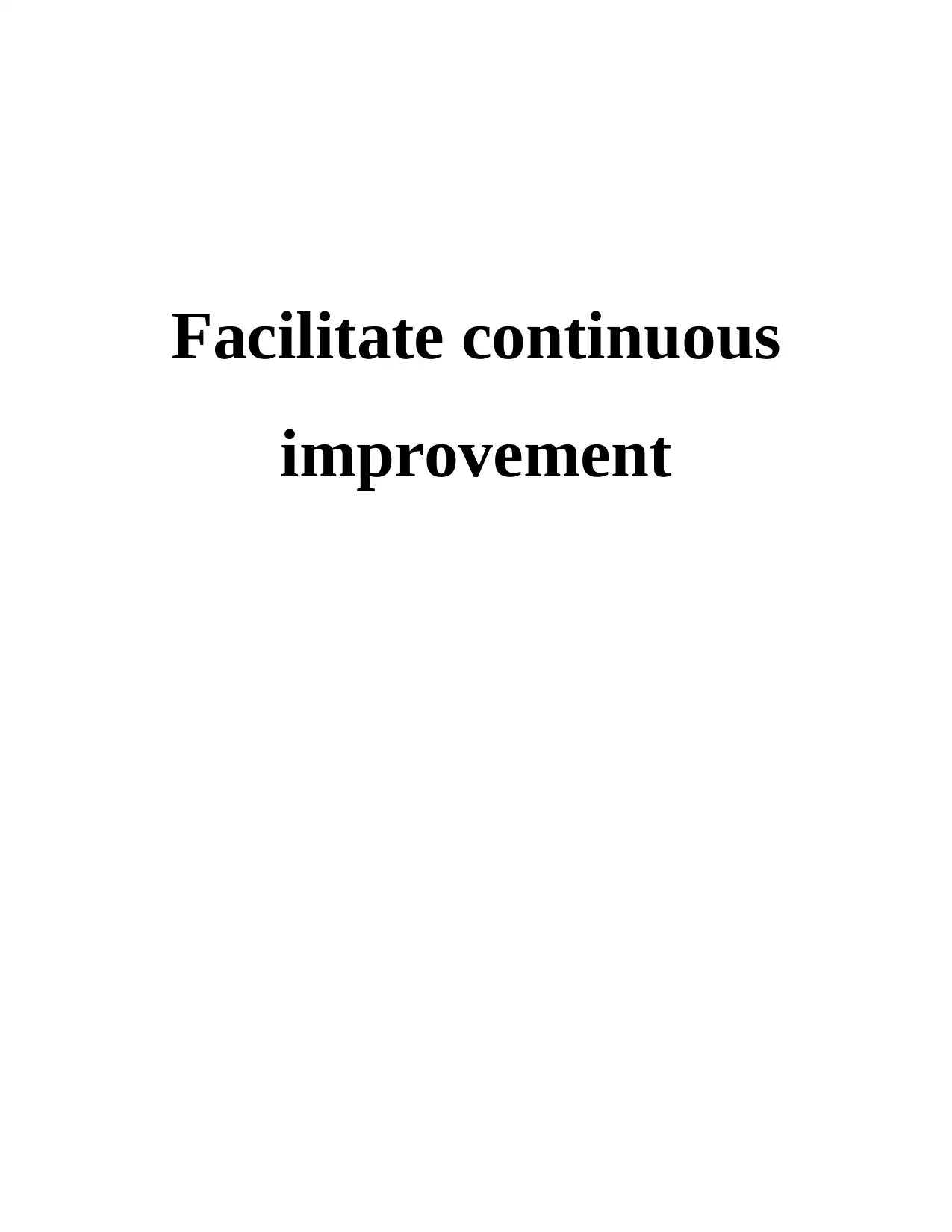
Facilitate continuous
improvement
improvement
Paraphrase This Document
Need a fresh take? Get an instant paraphrase of this document with our AI Paraphraser
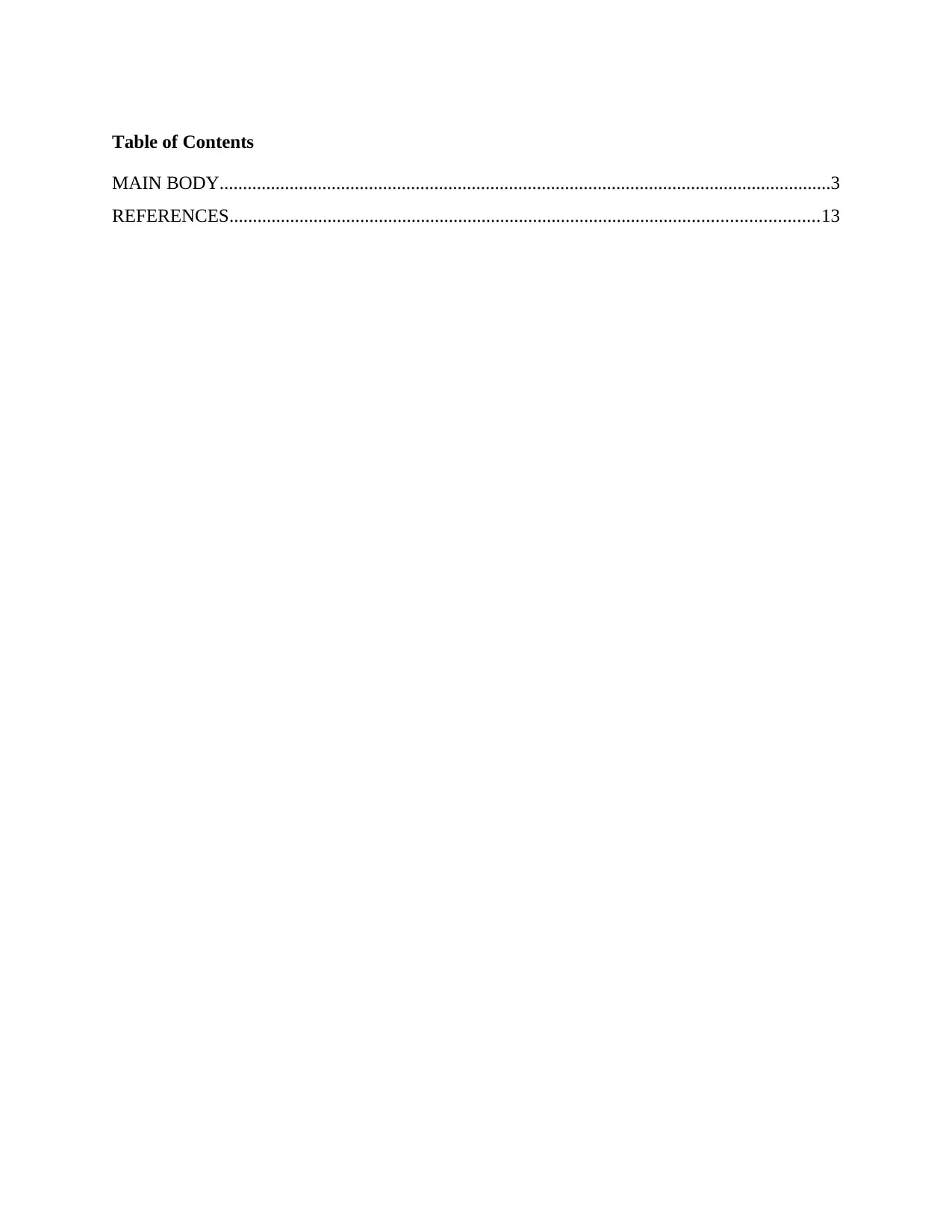
Table of Contents
MAIN BODY...................................................................................................................................3
REFERENCES..............................................................................................................................13
MAIN BODY...................................................................................................................................3
REFERENCES..............................................................................................................................13
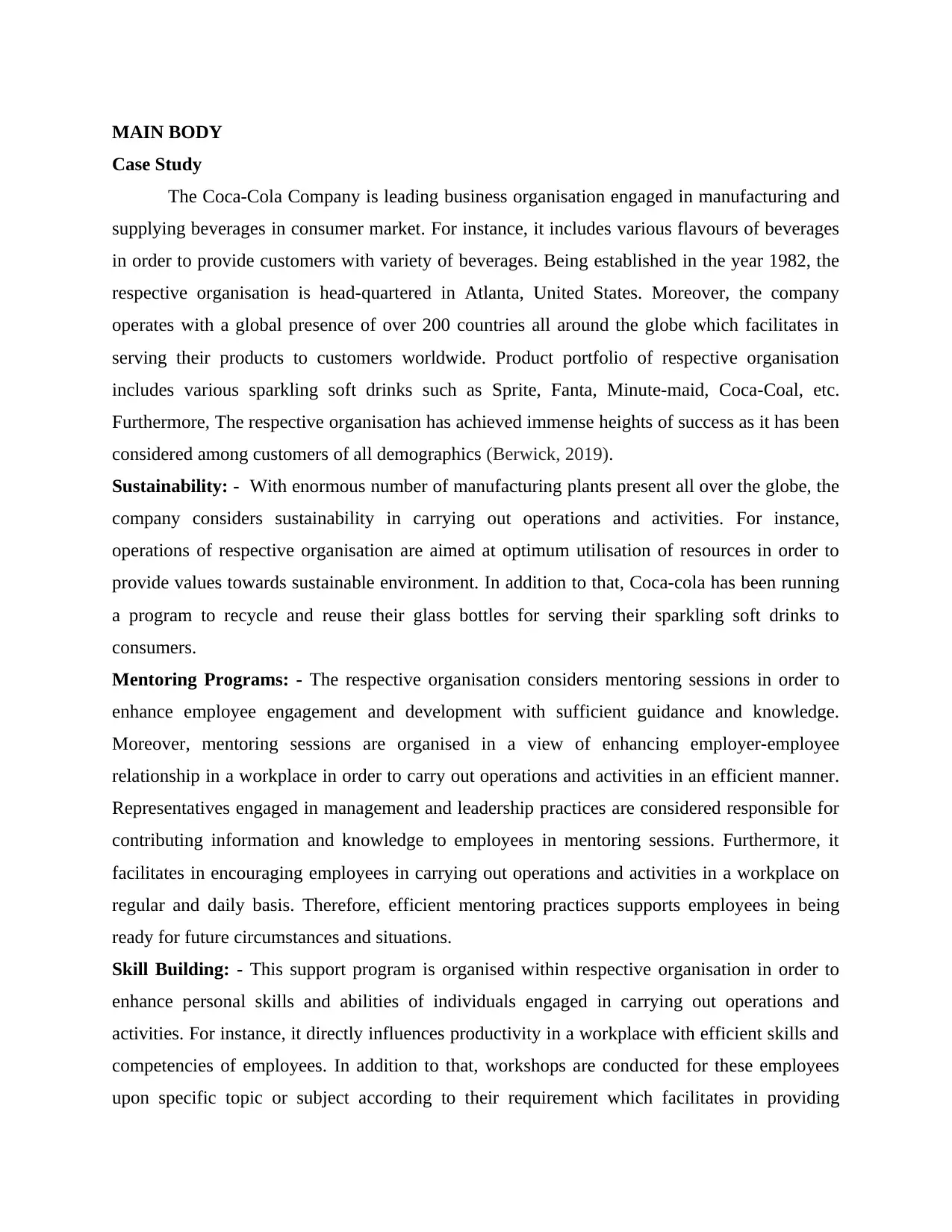
MAIN BODY
Case Study
The Coca-Cola Company is leading business organisation engaged in manufacturing and
supplying beverages in consumer market. For instance, it includes various flavours of beverages
in order to provide customers with variety of beverages. Being established in the year 1982, the
respective organisation is head-quartered in Atlanta, United States. Moreover, the company
operates with a global presence of over 200 countries all around the globe which facilitates in
serving their products to customers worldwide. Product portfolio of respective organisation
includes various sparkling soft drinks such as Sprite, Fanta, Minute-maid, Coca-Coal, etc.
Furthermore, The respective organisation has achieved immense heights of success as it has been
considered among customers of all demographics (Berwick, 2019).
Sustainability: - With enormous number of manufacturing plants present all over the globe, the
company considers sustainability in carrying out operations and activities. For instance,
operations of respective organisation are aimed at optimum utilisation of resources in order to
provide values towards sustainable environment. In addition to that, Coca-cola has been running
a program to recycle and reuse their glass bottles for serving their sparkling soft drinks to
consumers.
Mentoring Programs: - The respective organisation considers mentoring sessions in order to
enhance employee engagement and development with sufficient guidance and knowledge.
Moreover, mentoring sessions are organised in a view of enhancing employer-employee
relationship in a workplace in order to carry out operations and activities in an efficient manner.
Representatives engaged in management and leadership practices are considered responsible for
contributing information and knowledge to employees in mentoring sessions. Furthermore, it
facilitates in encouraging employees in carrying out operations and activities in a workplace on
regular and daily basis. Therefore, efficient mentoring practices supports employees in being
ready for future circumstances and situations.
Skill Building: - This support program is organised within respective organisation in order to
enhance personal skills and abilities of individuals engaged in carrying out operations and
activities. For instance, it directly influences productivity in a workplace with efficient skills and
competencies of employees. In addition to that, workshops are conducted for these employees
upon specific topic or subject according to their requirement which facilitates in providing
Case Study
The Coca-Cola Company is leading business organisation engaged in manufacturing and
supplying beverages in consumer market. For instance, it includes various flavours of beverages
in order to provide customers with variety of beverages. Being established in the year 1982, the
respective organisation is head-quartered in Atlanta, United States. Moreover, the company
operates with a global presence of over 200 countries all around the globe which facilitates in
serving their products to customers worldwide. Product portfolio of respective organisation
includes various sparkling soft drinks such as Sprite, Fanta, Minute-maid, Coca-Coal, etc.
Furthermore, The respective organisation has achieved immense heights of success as it has been
considered among customers of all demographics (Berwick, 2019).
Sustainability: - With enormous number of manufacturing plants present all over the globe, the
company considers sustainability in carrying out operations and activities. For instance,
operations of respective organisation are aimed at optimum utilisation of resources in order to
provide values towards sustainable environment. In addition to that, Coca-cola has been running
a program to recycle and reuse their glass bottles for serving their sparkling soft drinks to
consumers.
Mentoring Programs: - The respective organisation considers mentoring sessions in order to
enhance employee engagement and development with sufficient guidance and knowledge.
Moreover, mentoring sessions are organised in a view of enhancing employer-employee
relationship in a workplace in order to carry out operations and activities in an efficient manner.
Representatives engaged in management and leadership practices are considered responsible for
contributing information and knowledge to employees in mentoring sessions. Furthermore, it
facilitates in encouraging employees in carrying out operations and activities in a workplace on
regular and daily basis. Therefore, efficient mentoring practices supports employees in being
ready for future circumstances and situations.
Skill Building: - This support program is organised within respective organisation in order to
enhance personal skills and abilities of individuals engaged in carrying out operations and
activities. For instance, it directly influences productivity in a workplace with efficient skills and
competencies of employees. In addition to that, workshops are conducted for these employees
upon specific topic or subject according to their requirement which facilitates in providing
⊘ This is a preview!⊘
Do you want full access?
Subscribe today to unlock all pages.

Trusted by 1+ million students worldwide
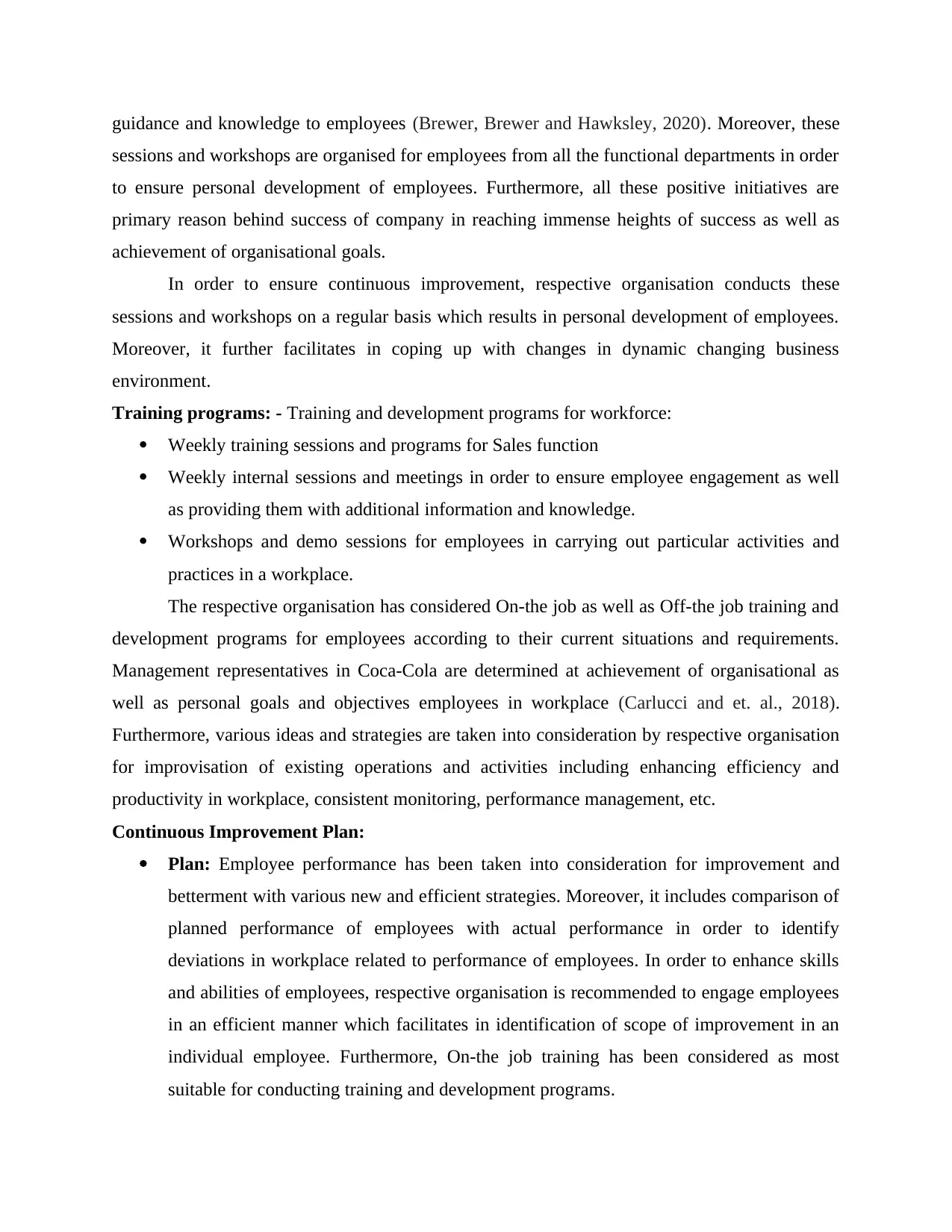
guidance and knowledge to employees (Brewer, Brewer and Hawksley, 2020). Moreover, these
sessions and workshops are organised for employees from all the functional departments in order
to ensure personal development of employees. Furthermore, all these positive initiatives are
primary reason behind success of company in reaching immense heights of success as well as
achievement of organisational goals.
In order to ensure continuous improvement, respective organisation conducts these
sessions and workshops on a regular basis which results in personal development of employees.
Moreover, it further facilitates in coping up with changes in dynamic changing business
environment.
Training programs: - Training and development programs for workforce:
Weekly training sessions and programs for Sales function
Weekly internal sessions and meetings in order to ensure employee engagement as well
as providing them with additional information and knowledge.
Workshops and demo sessions for employees in carrying out particular activities and
practices in a workplace.
The respective organisation has considered On-the job as well as Off-the job training and
development programs for employees according to their current situations and requirements.
Management representatives in Coca-Cola are determined at achievement of organisational as
well as personal goals and objectives employees in workplace (Carlucci and et. al., 2018).
Furthermore, various ideas and strategies are taken into consideration by respective organisation
for improvisation of existing operations and activities including enhancing efficiency and
productivity in workplace, consistent monitoring, performance management, etc.
Continuous Improvement Plan:
Plan: Employee performance has been taken into consideration for improvement and
betterment with various new and efficient strategies. Moreover, it includes comparison of
planned performance of employees with actual performance in order to identify
deviations in workplace related to performance of employees. In order to enhance skills
and abilities of employees, respective organisation is recommended to engage employees
in an efficient manner which facilitates in identification of scope of improvement in an
individual employee. Furthermore, On-the job training has been considered as most
suitable for conducting training and development programs.
sessions and workshops are organised for employees from all the functional departments in order
to ensure personal development of employees. Furthermore, all these positive initiatives are
primary reason behind success of company in reaching immense heights of success as well as
achievement of organisational goals.
In order to ensure continuous improvement, respective organisation conducts these
sessions and workshops on a regular basis which results in personal development of employees.
Moreover, it further facilitates in coping up with changes in dynamic changing business
environment.
Training programs: - Training and development programs for workforce:
Weekly training sessions and programs for Sales function
Weekly internal sessions and meetings in order to ensure employee engagement as well
as providing them with additional information and knowledge.
Workshops and demo sessions for employees in carrying out particular activities and
practices in a workplace.
The respective organisation has considered On-the job as well as Off-the job training and
development programs for employees according to their current situations and requirements.
Management representatives in Coca-Cola are determined at achievement of organisational as
well as personal goals and objectives employees in workplace (Carlucci and et. al., 2018).
Furthermore, various ideas and strategies are taken into consideration by respective organisation
for improvisation of existing operations and activities including enhancing efficiency and
productivity in workplace, consistent monitoring, performance management, etc.
Continuous Improvement Plan:
Plan: Employee performance has been taken into consideration for improvement and
betterment with various new and efficient strategies. Moreover, it includes comparison of
planned performance of employees with actual performance in order to identify
deviations in workplace related to performance of employees. In order to enhance skills
and abilities of employees, respective organisation is recommended to engage employees
in an efficient manner which facilitates in identification of scope of improvement in an
individual employee. Furthermore, On-the job training has been considered as most
suitable for conducting training and development programs.
Paraphrase This Document
Need a fresh take? Get an instant paraphrase of this document with our AI Paraphraser
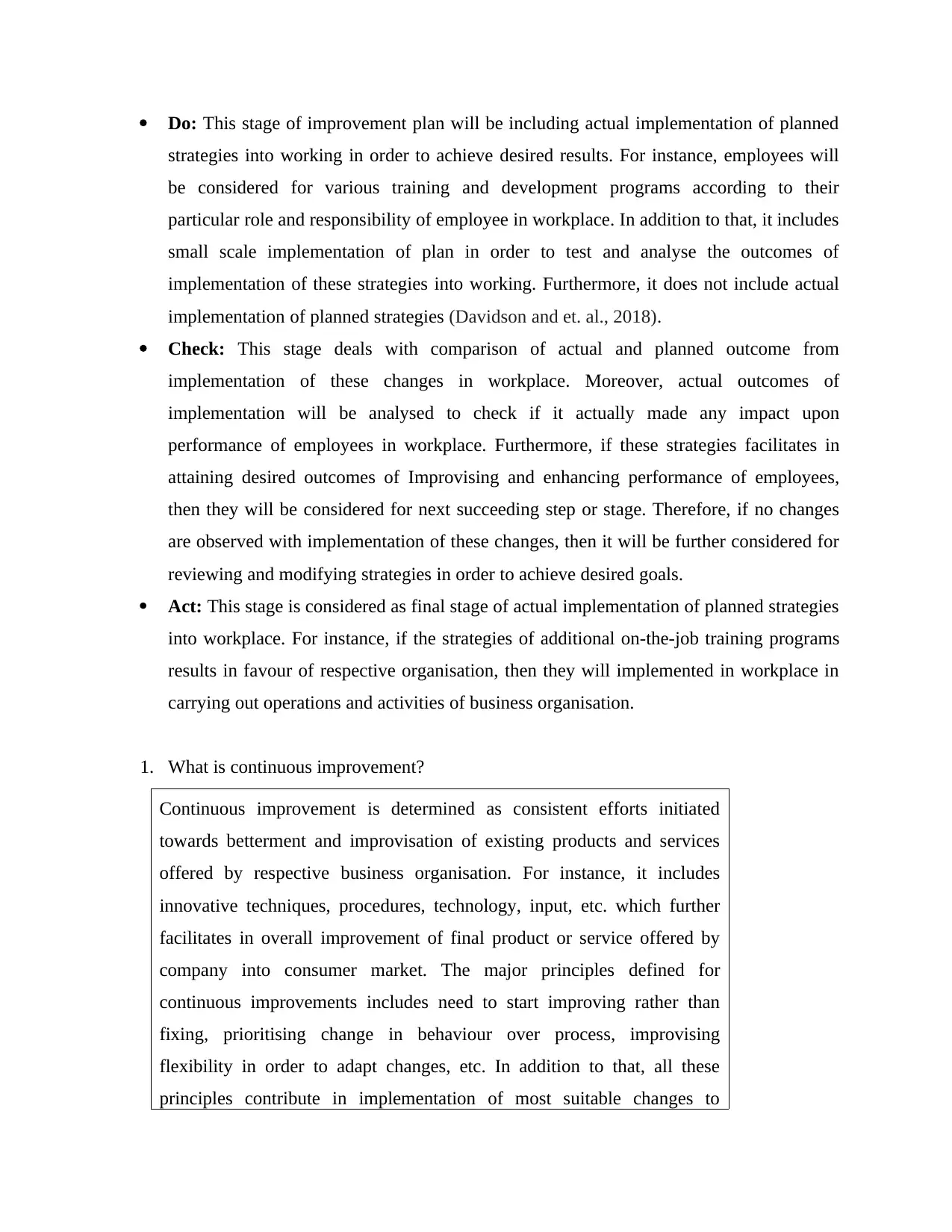
Do: This stage of improvement plan will be including actual implementation of planned
strategies into working in order to achieve desired results. For instance, employees will
be considered for various training and development programs according to their
particular role and responsibility of employee in workplace. In addition to that, it includes
small scale implementation of plan in order to test and analyse the outcomes of
implementation of these strategies into working. Furthermore, it does not include actual
implementation of planned strategies (Davidson and et. al., 2018).
Check: This stage deals with comparison of actual and planned outcome from
implementation of these changes in workplace. Moreover, actual outcomes of
implementation will be analysed to check if it actually made any impact upon
performance of employees in workplace. Furthermore, if these strategies facilitates in
attaining desired outcomes of Improvising and enhancing performance of employees,
then they will be considered for next succeeding step or stage. Therefore, if no changes
are observed with implementation of these changes, then it will be further considered for
reviewing and modifying strategies in order to achieve desired goals.
Act: This stage is considered as final stage of actual implementation of planned strategies
into workplace. For instance, if the strategies of additional on-the-job training programs
results in favour of respective organisation, then they will implemented in workplace in
carrying out operations and activities of business organisation.
1. What is continuous improvement?
Continuous improvement is determined as consistent efforts initiated
towards betterment and improvisation of existing products and services
offered by respective business organisation. For instance, it includes
innovative techniques, procedures, technology, input, etc. which further
facilitates in overall improvement of final product or service offered by
company into consumer market. The major principles defined for
continuous improvements includes need to start improving rather than
fixing, prioritising change in behaviour over process, improvising
flexibility in order to adapt changes, etc. In addition to that, all these
principles contribute in implementation of most suitable changes to
strategies into working in order to achieve desired results. For instance, employees will
be considered for various training and development programs according to their
particular role and responsibility of employee in workplace. In addition to that, it includes
small scale implementation of plan in order to test and analyse the outcomes of
implementation of these strategies into working. Furthermore, it does not include actual
implementation of planned strategies (Davidson and et. al., 2018).
Check: This stage deals with comparison of actual and planned outcome from
implementation of these changes in workplace. Moreover, actual outcomes of
implementation will be analysed to check if it actually made any impact upon
performance of employees in workplace. Furthermore, if these strategies facilitates in
attaining desired outcomes of Improvising and enhancing performance of employees,
then they will be considered for next succeeding step or stage. Therefore, if no changes
are observed with implementation of these changes, then it will be further considered for
reviewing and modifying strategies in order to achieve desired goals.
Act: This stage is considered as final stage of actual implementation of planned strategies
into workplace. For instance, if the strategies of additional on-the-job training programs
results in favour of respective organisation, then they will implemented in workplace in
carrying out operations and activities of business organisation.
1. What is continuous improvement?
Continuous improvement is determined as consistent efforts initiated
towards betterment and improvisation of existing products and services
offered by respective business organisation. For instance, it includes
innovative techniques, procedures, technology, input, etc. which further
facilitates in overall improvement of final product or service offered by
company into consumer market. The major principles defined for
continuous improvements includes need to start improving rather than
fixing, prioritising change in behaviour over process, improvising
flexibility in order to adapt changes, etc. In addition to that, all these
principles contribute in implementation of most suitable changes to
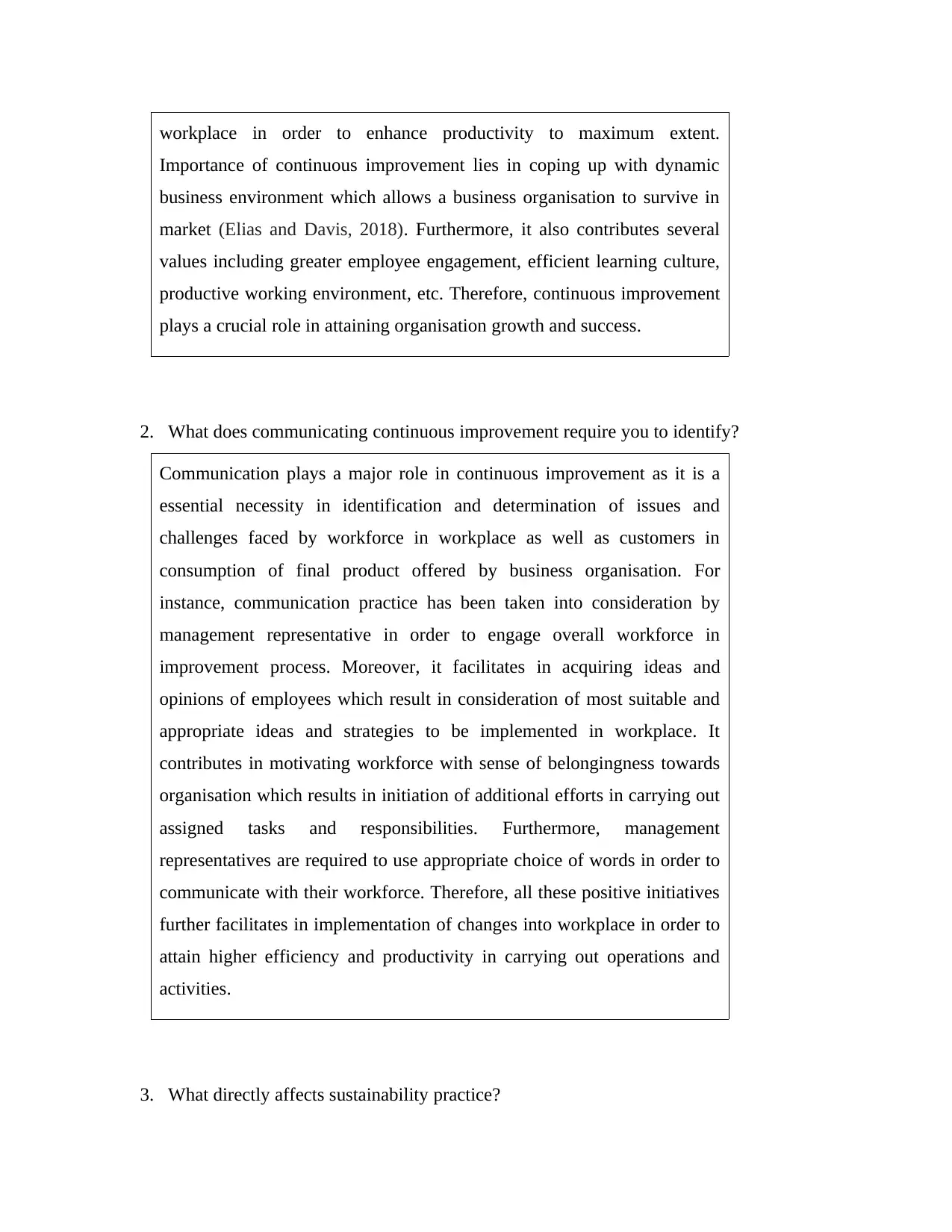
workplace in order to enhance productivity to maximum extent.
Importance of continuous improvement lies in coping up with dynamic
business environment which allows a business organisation to survive in
market (Elias and Davis, 2018). Furthermore, it also contributes several
values including greater employee engagement, efficient learning culture,
productive working environment, etc. Therefore, continuous improvement
plays a crucial role in attaining organisation growth and success.
2. What does communicating continuous improvement require you to identify?
Communication plays a major role in continuous improvement as it is a
essential necessity in identification and determination of issues and
challenges faced by workforce in workplace as well as customers in
consumption of final product offered by business organisation. For
instance, communication practice has been taken into consideration by
management representative in order to engage overall workforce in
improvement process. Moreover, it facilitates in acquiring ideas and
opinions of employees which result in consideration of most suitable and
appropriate ideas and strategies to be implemented in workplace. It
contributes in motivating workforce with sense of belongingness towards
organisation which results in initiation of additional efforts in carrying out
assigned tasks and responsibilities. Furthermore, management
representatives are required to use appropriate choice of words in order to
communicate with their workforce. Therefore, all these positive initiatives
further facilitates in implementation of changes into workplace in order to
attain higher efficiency and productivity in carrying out operations and
activities.
3. What directly affects sustainability practice?
Importance of continuous improvement lies in coping up with dynamic
business environment which allows a business organisation to survive in
market (Elias and Davis, 2018). Furthermore, it also contributes several
values including greater employee engagement, efficient learning culture,
productive working environment, etc. Therefore, continuous improvement
plays a crucial role in attaining organisation growth and success.
2. What does communicating continuous improvement require you to identify?
Communication plays a major role in continuous improvement as it is a
essential necessity in identification and determination of issues and
challenges faced by workforce in workplace as well as customers in
consumption of final product offered by business organisation. For
instance, communication practice has been taken into consideration by
management representative in order to engage overall workforce in
improvement process. Moreover, it facilitates in acquiring ideas and
opinions of employees which result in consideration of most suitable and
appropriate ideas and strategies to be implemented in workplace. It
contributes in motivating workforce with sense of belongingness towards
organisation which results in initiation of additional efforts in carrying out
assigned tasks and responsibilities. Furthermore, management
representatives are required to use appropriate choice of words in order to
communicate with their workforce. Therefore, all these positive initiatives
further facilitates in implementation of changes into workplace in order to
attain higher efficiency and productivity in carrying out operations and
activities.
3. What directly affects sustainability practice?
⊘ This is a preview!⊘
Do you want full access?
Subscribe today to unlock all pages.

Trusted by 1+ million students worldwide
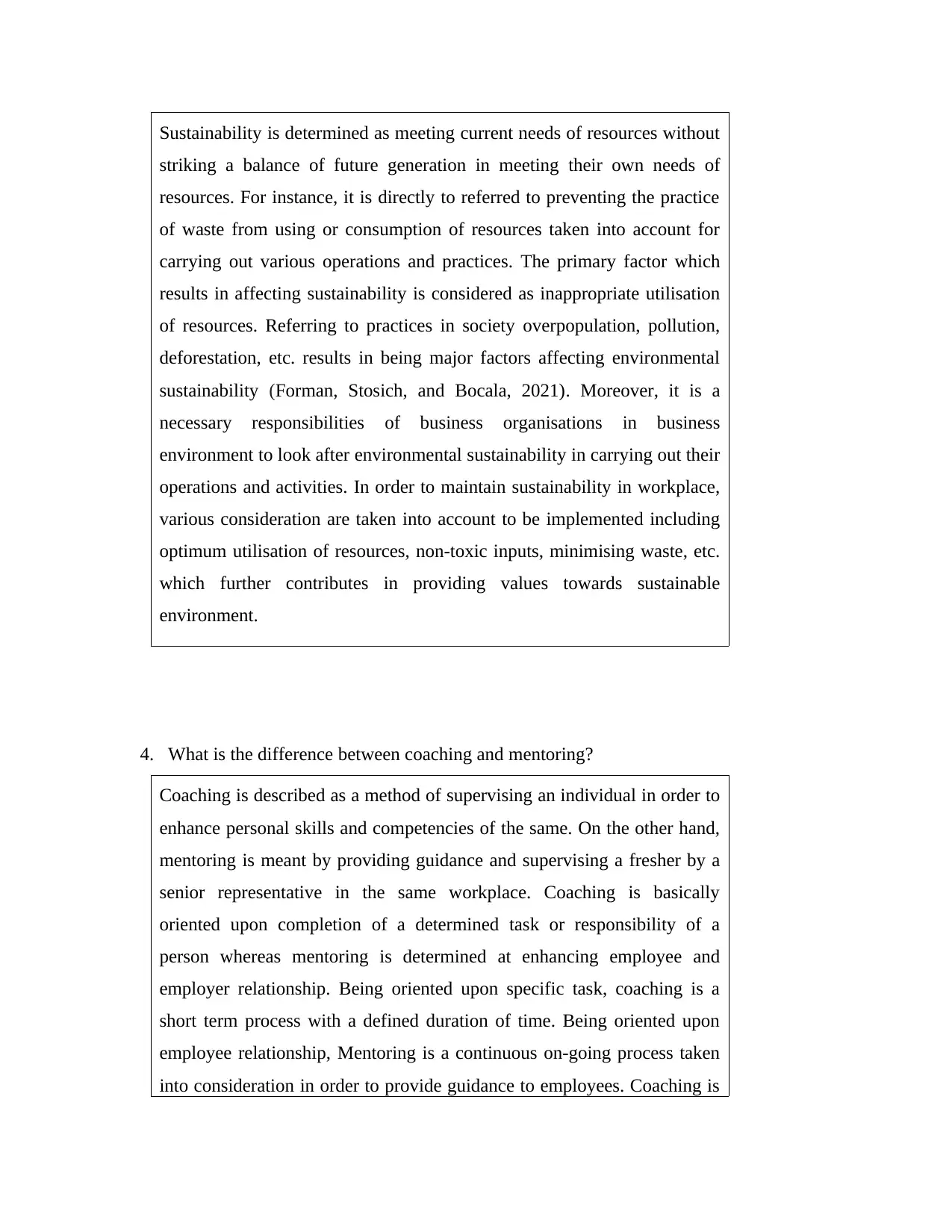
Sustainability is determined as meeting current needs of resources without
striking a balance of future generation in meeting their own needs of
resources. For instance, it is directly to referred to preventing the practice
of waste from using or consumption of resources taken into account for
carrying out various operations and practices. The primary factor which
results in affecting sustainability is considered as inappropriate utilisation
of resources. Referring to practices in society overpopulation, pollution,
deforestation, etc. results in being major factors affecting environmental
sustainability (Forman, Stosich, and Bocala, 2021). Moreover, it is a
necessary responsibilities of business organisations in business
environment to look after environmental sustainability in carrying out their
operations and activities. In order to maintain sustainability in workplace,
various consideration are taken into account to be implemented including
optimum utilisation of resources, non-toxic inputs, minimising waste, etc.
which further contributes in providing values towards sustainable
environment.
4. What is the difference between coaching and mentoring?
Coaching is described as a method of supervising an individual in order to
enhance personal skills and competencies of the same. On the other hand,
mentoring is meant by providing guidance and supervising a fresher by a
senior representative in the same workplace. Coaching is basically
oriented upon completion of a determined task or responsibility of a
person whereas mentoring is determined at enhancing employee and
employer relationship. Being oriented upon specific task, coaching is a
short term process with a defined duration of time. Being oriented upon
employee relationship, Mentoring is a continuous on-going process taken
into consideration in order to provide guidance to employees. Coaching is
striking a balance of future generation in meeting their own needs of
resources. For instance, it is directly to referred to preventing the practice
of waste from using or consumption of resources taken into account for
carrying out various operations and practices. The primary factor which
results in affecting sustainability is considered as inappropriate utilisation
of resources. Referring to practices in society overpopulation, pollution,
deforestation, etc. results in being major factors affecting environmental
sustainability (Forman, Stosich, and Bocala, 2021). Moreover, it is a
necessary responsibilities of business organisations in business
environment to look after environmental sustainability in carrying out their
operations and activities. In order to maintain sustainability in workplace,
various consideration are taken into account to be implemented including
optimum utilisation of resources, non-toxic inputs, minimising waste, etc.
which further contributes in providing values towards sustainable
environment.
4. What is the difference between coaching and mentoring?
Coaching is described as a method of supervising an individual in order to
enhance personal skills and competencies of the same. On the other hand,
mentoring is meant by providing guidance and supervising a fresher by a
senior representative in the same workplace. Coaching is basically
oriented upon completion of a determined task or responsibility of a
person whereas mentoring is determined at enhancing employee and
employer relationship. Being oriented upon specific task, coaching is a
short term process with a defined duration of time. Being oriented upon
employee relationship, Mentoring is a continuous on-going process taken
into consideration in order to provide guidance to employees. Coaching is
Paraphrase This Document
Need a fresh take? Get an instant paraphrase of this document with our AI Paraphraser
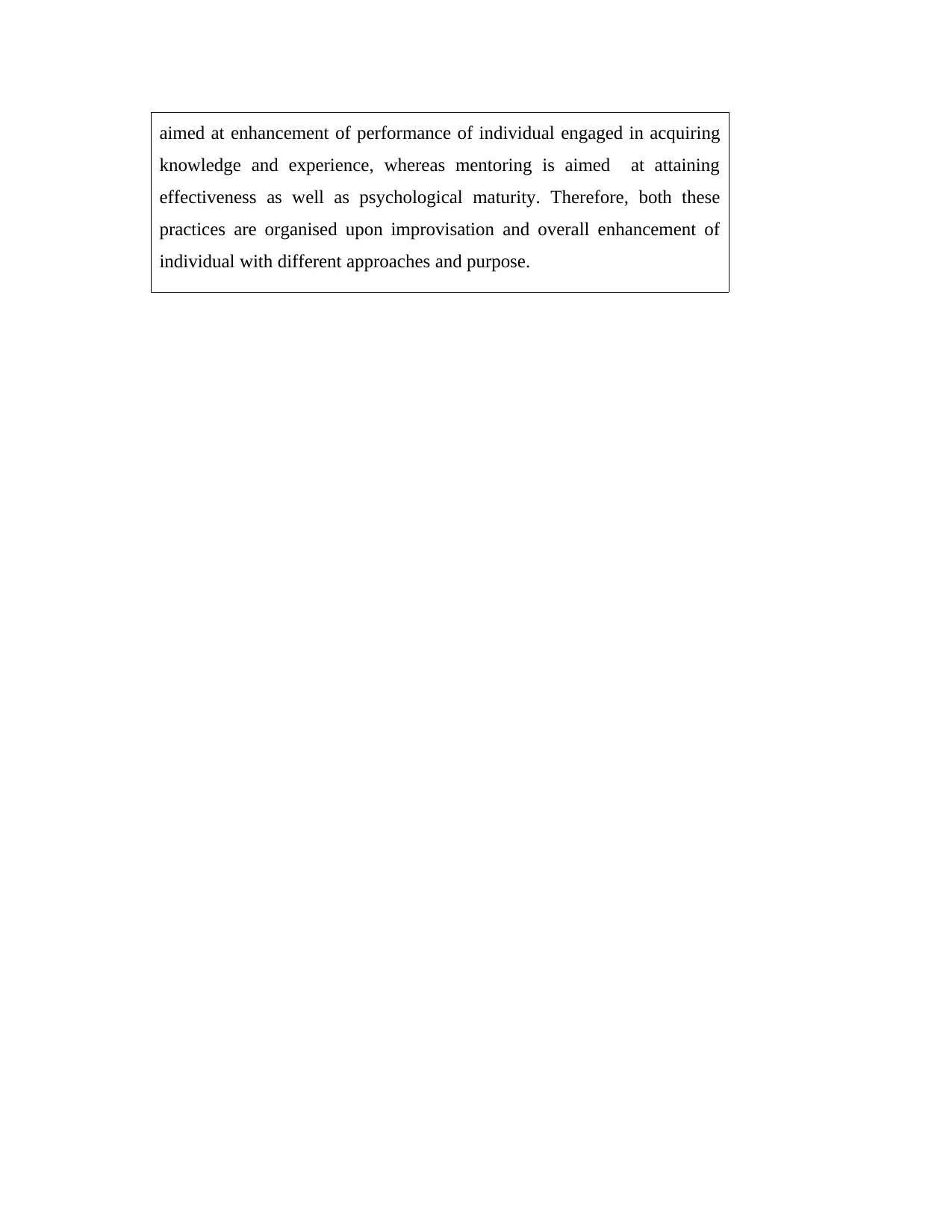
aimed at enhancement of performance of individual engaged in acquiring
knowledge and experience, whereas mentoring is aimed at attaining
effectiveness as well as psychological maturity. Therefore, both these
practices are organised upon improvisation and overall enhancement of
individual with different approaches and purpose.
knowledge and experience, whereas mentoring is aimed at attaining
effectiveness as well as psychological maturity. Therefore, both these
practices are organised upon improvisation and overall enhancement of
individual with different approaches and purpose.
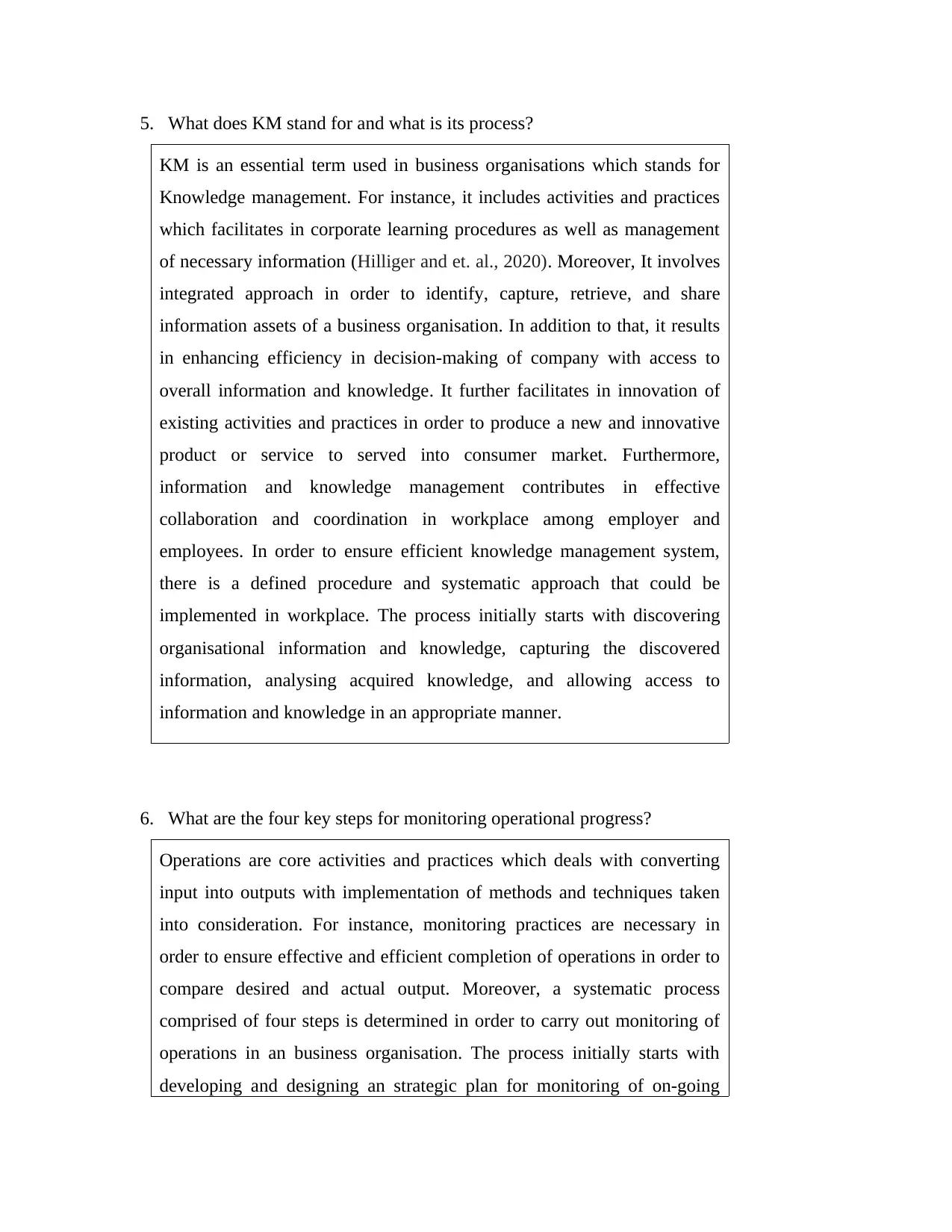
5. What does KM stand for and what is its process?
KM is an essential term used in business organisations which stands for
Knowledge management. For instance, it includes activities and practices
which facilitates in corporate learning procedures as well as management
of necessary information (Hilliger and et. al., 2020). Moreover, It involves
integrated approach in order to identify, capture, retrieve, and share
information assets of a business organisation. In addition to that, it results
in enhancing efficiency in decision-making of company with access to
overall information and knowledge. It further facilitates in innovation of
existing activities and practices in order to produce a new and innovative
product or service to served into consumer market. Furthermore,
information and knowledge management contributes in effective
collaboration and coordination in workplace among employer and
employees. In order to ensure efficient knowledge management system,
there is a defined procedure and systematic approach that could be
implemented in workplace. The process initially starts with discovering
organisational information and knowledge, capturing the discovered
information, analysing acquired knowledge, and allowing access to
information and knowledge in an appropriate manner.
6. What are the four key steps for monitoring operational progress?
Operations are core activities and practices which deals with converting
input into outputs with implementation of methods and techniques taken
into consideration. For instance, monitoring practices are necessary in
order to ensure effective and efficient completion of operations in order to
compare desired and actual output. Moreover, a systematic process
comprised of four steps is determined in order to carry out monitoring of
operations in an business organisation. The process initially starts with
developing and designing an strategic plan for monitoring of on-going
KM is an essential term used in business organisations which stands for
Knowledge management. For instance, it includes activities and practices
which facilitates in corporate learning procedures as well as management
of necessary information (Hilliger and et. al., 2020). Moreover, It involves
integrated approach in order to identify, capture, retrieve, and share
information assets of a business organisation. In addition to that, it results
in enhancing efficiency in decision-making of company with access to
overall information and knowledge. It further facilitates in innovation of
existing activities and practices in order to produce a new and innovative
product or service to served into consumer market. Furthermore,
information and knowledge management contributes in effective
collaboration and coordination in workplace among employer and
employees. In order to ensure efficient knowledge management system,
there is a defined procedure and systematic approach that could be
implemented in workplace. The process initially starts with discovering
organisational information and knowledge, capturing the discovered
information, analysing acquired knowledge, and allowing access to
information and knowledge in an appropriate manner.
6. What are the four key steps for monitoring operational progress?
Operations are core activities and practices which deals with converting
input into outputs with implementation of methods and techniques taken
into consideration. For instance, monitoring practices are necessary in
order to ensure effective and efficient completion of operations in order to
compare desired and actual output. Moreover, a systematic process
comprised of four steps is determined in order to carry out monitoring of
operations in an business organisation. The process initially starts with
developing and designing an strategic plan for monitoring of on-going
⊘ This is a preview!⊘
Do you want full access?
Subscribe today to unlock all pages.

Trusted by 1+ million students worldwide
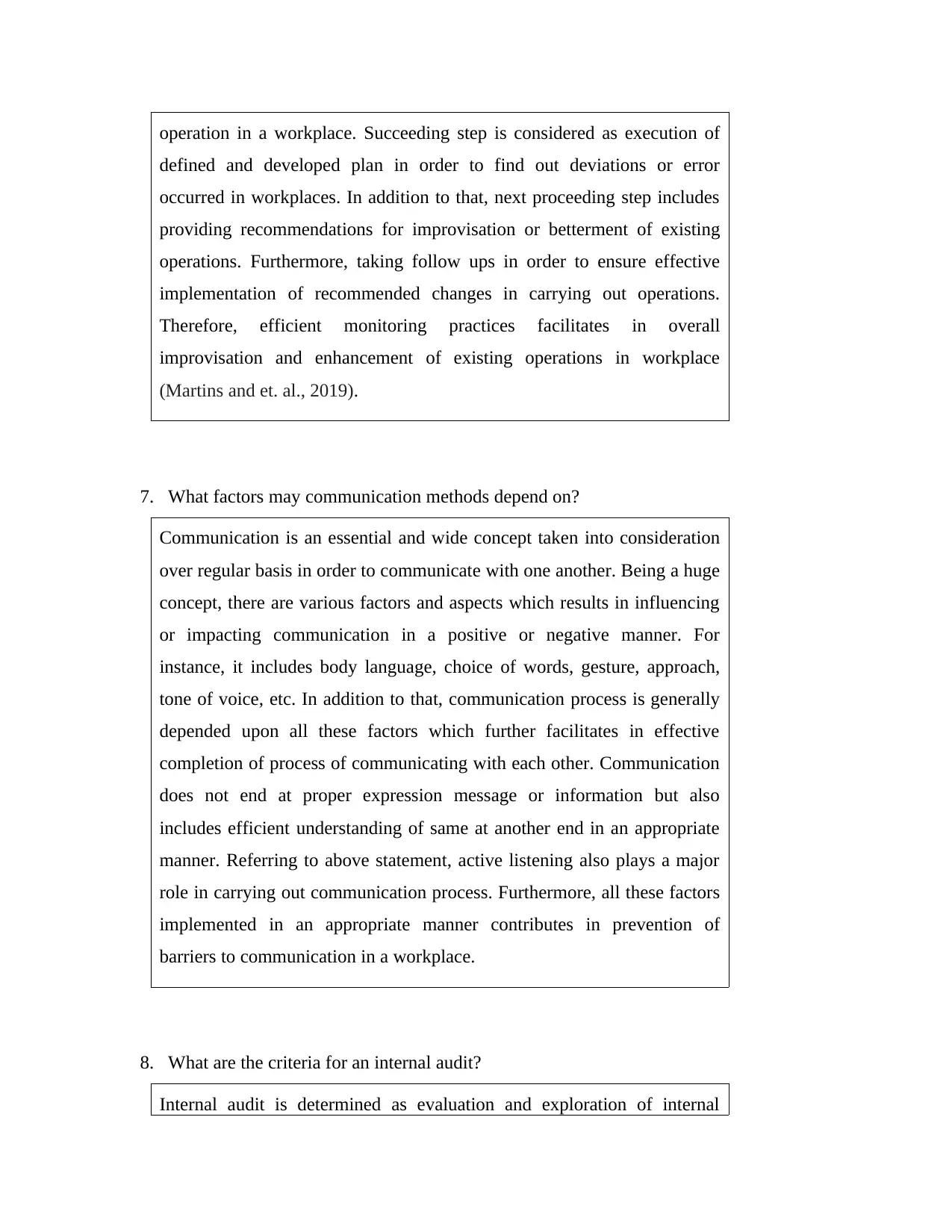
operation in a workplace. Succeeding step is considered as execution of
defined and developed plan in order to find out deviations or error
occurred in workplaces. In addition to that, next proceeding step includes
providing recommendations for improvisation or betterment of existing
operations. Furthermore, taking follow ups in order to ensure effective
implementation of recommended changes in carrying out operations.
Therefore, efficient monitoring practices facilitates in overall
improvisation and enhancement of existing operations in workplace
(Martins and et. al., 2019).
7. What factors may communication methods depend on?
Communication is an essential and wide concept taken into consideration
over regular basis in order to communicate with one another. Being a huge
concept, there are various factors and aspects which results in influencing
or impacting communication in a positive or negative manner. For
instance, it includes body language, choice of words, gesture, approach,
tone of voice, etc. In addition to that, communication process is generally
depended upon all these factors which further facilitates in effective
completion of process of communicating with each other. Communication
does not end at proper expression message or information but also
includes efficient understanding of same at another end in an appropriate
manner. Referring to above statement, active listening also plays a major
role in carrying out communication process. Furthermore, all these factors
implemented in an appropriate manner contributes in prevention of
barriers to communication in a workplace.
8. What are the criteria for an internal audit?
Internal audit is determined as evaluation and exploration of internal
defined and developed plan in order to find out deviations or error
occurred in workplaces. In addition to that, next proceeding step includes
providing recommendations for improvisation or betterment of existing
operations. Furthermore, taking follow ups in order to ensure effective
implementation of recommended changes in carrying out operations.
Therefore, efficient monitoring practices facilitates in overall
improvisation and enhancement of existing operations in workplace
(Martins and et. al., 2019).
7. What factors may communication methods depend on?
Communication is an essential and wide concept taken into consideration
over regular basis in order to communicate with one another. Being a huge
concept, there are various factors and aspects which results in influencing
or impacting communication in a positive or negative manner. For
instance, it includes body language, choice of words, gesture, approach,
tone of voice, etc. In addition to that, communication process is generally
depended upon all these factors which further facilitates in effective
completion of process of communicating with each other. Communication
does not end at proper expression message or information but also
includes efficient understanding of same at another end in an appropriate
manner. Referring to above statement, active listening also plays a major
role in carrying out communication process. Furthermore, all these factors
implemented in an appropriate manner contributes in prevention of
barriers to communication in a workplace.
8. What are the criteria for an internal audit?
Internal audit is determined as evaluation and exploration of internal
Paraphrase This Document
Need a fresh take? Get an instant paraphrase of this document with our AI Paraphraser
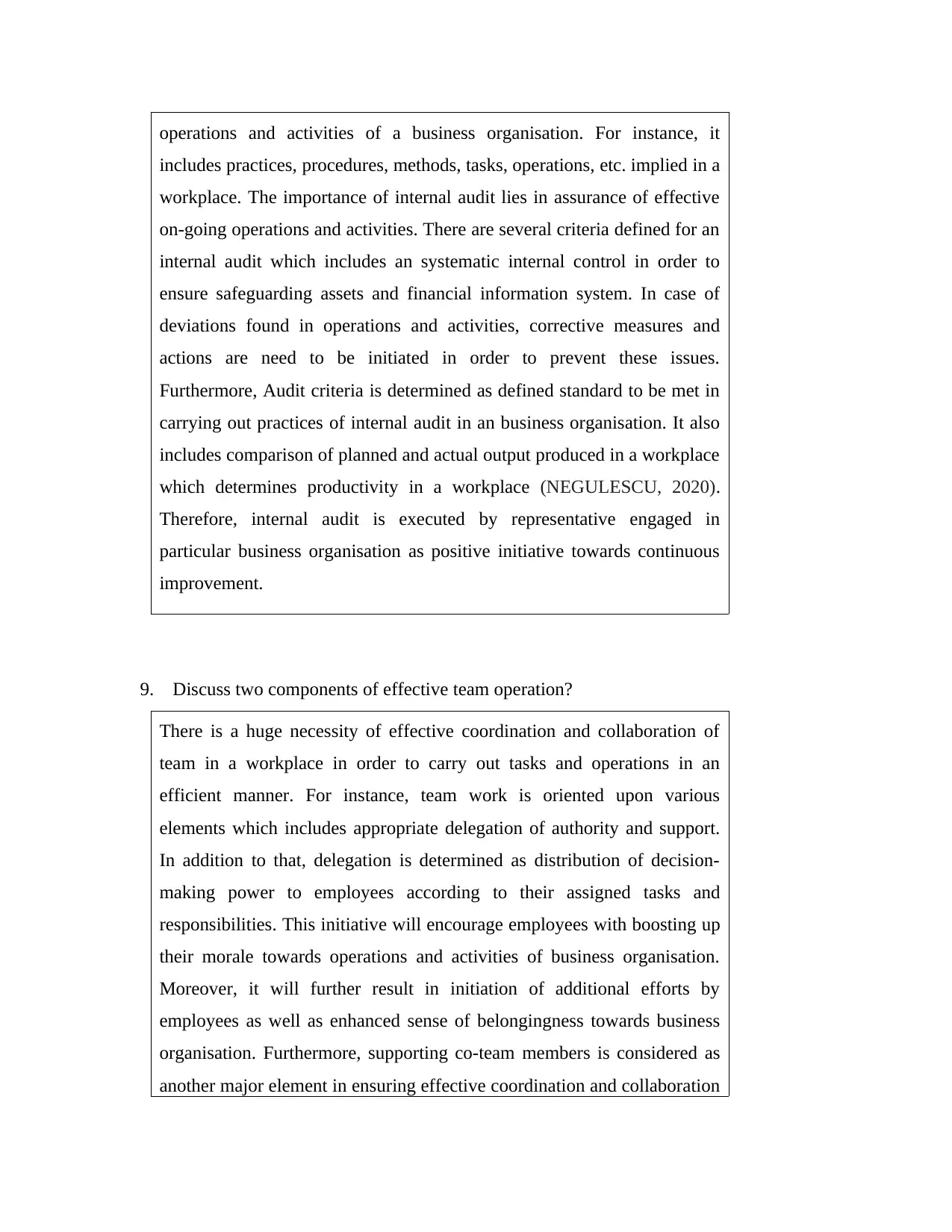
operations and activities of a business organisation. For instance, it
includes practices, procedures, methods, tasks, operations, etc. implied in a
workplace. The importance of internal audit lies in assurance of effective
on-going operations and activities. There are several criteria defined for an
internal audit which includes an systematic internal control in order to
ensure safeguarding assets and financial information system. In case of
deviations found in operations and activities, corrective measures and
actions are need to be initiated in order to prevent these issues.
Furthermore, Audit criteria is determined as defined standard to be met in
carrying out practices of internal audit in an business organisation. It also
includes comparison of planned and actual output produced in a workplace
which determines productivity in a workplace (NEGULESCU, 2020).
Therefore, internal audit is executed by representative engaged in
particular business organisation as positive initiative towards continuous
improvement.
9. Discuss two components of effective team operation?
There is a huge necessity of effective coordination and collaboration of
team in a workplace in order to carry out tasks and operations in an
efficient manner. For instance, team work is oriented upon various
elements which includes appropriate delegation of authority and support.
In addition to that, delegation is determined as distribution of decision-
making power to employees according to their assigned tasks and
responsibilities. This initiative will encourage employees with boosting up
their morale towards operations and activities of business organisation.
Moreover, it will further result in initiation of additional efforts by
employees as well as enhanced sense of belongingness towards business
organisation. Furthermore, supporting co-team members is considered as
another major element in ensuring effective coordination and collaboration
includes practices, procedures, methods, tasks, operations, etc. implied in a
workplace. The importance of internal audit lies in assurance of effective
on-going operations and activities. There are several criteria defined for an
internal audit which includes an systematic internal control in order to
ensure safeguarding assets and financial information system. In case of
deviations found in operations and activities, corrective measures and
actions are need to be initiated in order to prevent these issues.
Furthermore, Audit criteria is determined as defined standard to be met in
carrying out practices of internal audit in an business organisation. It also
includes comparison of planned and actual output produced in a workplace
which determines productivity in a workplace (NEGULESCU, 2020).
Therefore, internal audit is executed by representative engaged in
particular business organisation as positive initiative towards continuous
improvement.
9. Discuss two components of effective team operation?
There is a huge necessity of effective coordination and collaboration of
team in a workplace in order to carry out tasks and operations in an
efficient manner. For instance, team work is oriented upon various
elements which includes appropriate delegation of authority and support.
In addition to that, delegation is determined as distribution of decision-
making power to employees according to their assigned tasks and
responsibilities. This initiative will encourage employees with boosting up
their morale towards operations and activities of business organisation.
Moreover, it will further result in initiation of additional efforts by
employees as well as enhanced sense of belongingness towards business
organisation. Furthermore, supporting co-team members is considered as
another major element in ensuring effective coordination and collaboration
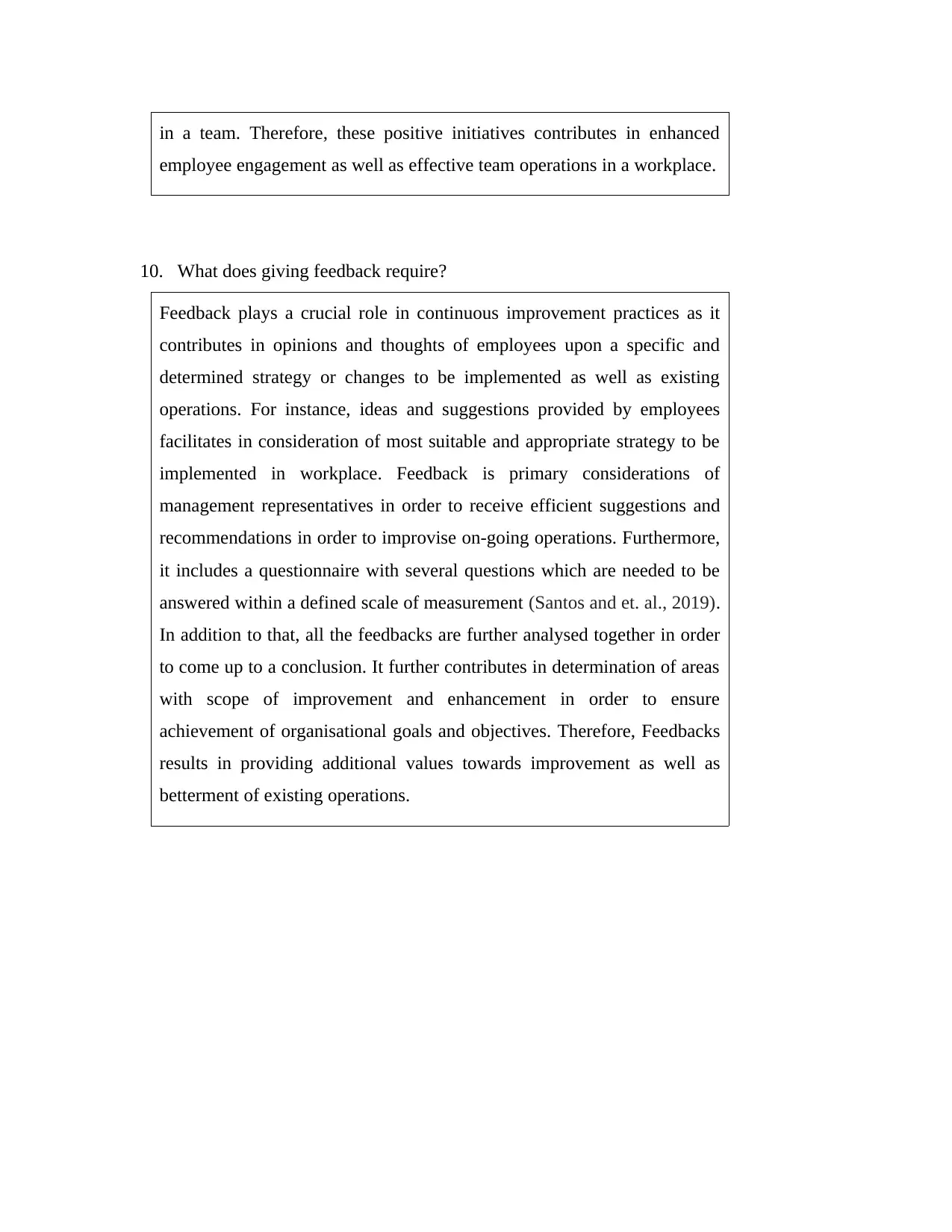
in a team. Therefore, these positive initiatives contributes in enhanced
employee engagement as well as effective team operations in a workplace.
10. What does giving feedback require?
Feedback plays a crucial role in continuous improvement practices as it
contributes in opinions and thoughts of employees upon a specific and
determined strategy or changes to be implemented as well as existing
operations. For instance, ideas and suggestions provided by employees
facilitates in consideration of most suitable and appropriate strategy to be
implemented in workplace. Feedback is primary considerations of
management representatives in order to receive efficient suggestions and
recommendations in order to improvise on-going operations. Furthermore,
it includes a questionnaire with several questions which are needed to be
answered within a defined scale of measurement (Santos and et. al., 2019).
In addition to that, all the feedbacks are further analysed together in order
to come up to a conclusion. It further contributes in determination of areas
with scope of improvement and enhancement in order to ensure
achievement of organisational goals and objectives. Therefore, Feedbacks
results in providing additional values towards improvement as well as
betterment of existing operations.
employee engagement as well as effective team operations in a workplace.
10. What does giving feedback require?
Feedback plays a crucial role in continuous improvement practices as it
contributes in opinions and thoughts of employees upon a specific and
determined strategy or changes to be implemented as well as existing
operations. For instance, ideas and suggestions provided by employees
facilitates in consideration of most suitable and appropriate strategy to be
implemented in workplace. Feedback is primary considerations of
management representatives in order to receive efficient suggestions and
recommendations in order to improvise on-going operations. Furthermore,
it includes a questionnaire with several questions which are needed to be
answered within a defined scale of measurement (Santos and et. al., 2019).
In addition to that, all the feedbacks are further analysed together in order
to come up to a conclusion. It further contributes in determination of areas
with scope of improvement and enhancement in order to ensure
achievement of organisational goals and objectives. Therefore, Feedbacks
results in providing additional values towards improvement as well as
betterment of existing operations.
⊘ This is a preview!⊘
Do you want full access?
Subscribe today to unlock all pages.

Trusted by 1+ million students worldwide
1 out of 13
Related Documents
Your All-in-One AI-Powered Toolkit for Academic Success.
+13062052269
info@desklib.com
Available 24*7 on WhatsApp / Email
![[object Object]](/_next/static/media/star-bottom.7253800d.svg)
Unlock your academic potential
Copyright © 2020–2025 A2Z Services. All Rights Reserved. Developed and managed by ZUCOL.



